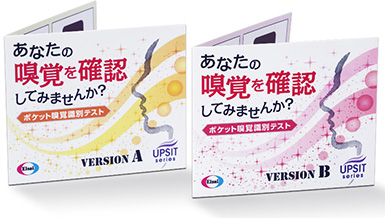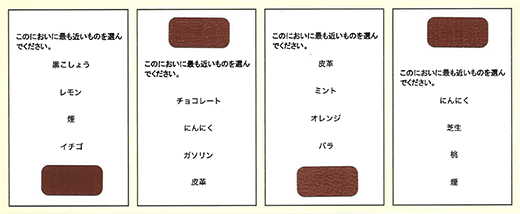- For Print
- April 3, 2017
(UPSIT SERIES ended as of August 2022.)
Eisai Co., Ltd. (Headquarters: Tokyo, CEO: Haruo Naito, “Eisai”) has announced that the smell identification test “UPSIT Series” will be launched today for sale to health insurance pharmacies and local governments in Japan. The UPSIT Series was developed by Sensonics International (Headquarters: New Jersey, USA; CEO: Richard L. Doty). Eisai has obtained exclusive rights to market the test in Japan, and has modified it for the Japanese market.
The UPSIT Series' 4-Item Pocket Smell Test is a multiple-choice test comprised of four microencapsulated odorant strips attached to a thick sheet of paper. The scents are released by lightly scratching the strips with a cotton swab or other tool, after which the person taking the test must attempt to select the correct name of the scent from four options that are provided. In this way, smell identification ability can be determined in approximately 3 minutes.
The sense of smell is one of the important senses for detecting hazards in daily life, such as rotten food, poor hygiene, gas leakage, and fires. Olfactory function, which includes the ability to identify smells (identification) and to detect a faint smell (detection), is influenced by age, physical condition, memory, and psychological state. Persons are often unaware the changes in the ability to identify smells, subjectively. The UPSIT Series, which objectively measures smell identification ability, makes it possible to detect and track changes in physical condition and psychological state.
This test will most likely be used in counseling sessions, such as during health consultations or health promotion events held by health insurance pharmacies or local governments. Should the person taking the test make any mistakes, it may be recommended that they undertake a review of their lifestyle, including sleep, exercise, dietary and smoking habits, under the guidance of a pharmacist or other relevant person. Alternatively, a visit to an otolaryngologist or a primary care physician may be recommended. It is important to note that the UPSIT Series is not an alternative for proper medical examinations and diagnosis by qualified medical professionals.
Scents are made up of multiple chemical substances. The roof of the nasal cavity contains 5 million olfactory receptor cells, each of which reacts to certain chemical substances. These cells work in concert to transmit smell information to the brain. The transmitted information is then integrated with information stored in the brain, including learned information, making it possible to identify “a certain smell”.
As one part of the hhc solutions business, Eisai has been engaged for many years in activities for “creating communities where senior citizens can live in peace of mind”. In carrying out these activities, Eisai has identified real world needs and issues, also called “clinical questions”. By providing solutions to these clinical questions, in cooperation with stakeholders including local governments, medical institutions and pharmacies, Eisai seeks to make further contributions to support health promotion and health management of senior citizens.
< Notes to editors >
1.About smell identification test UPSIT Series
The UPSIT Series' 4-Item Pocket Smell Test is a multiple-choice test comprised of a four microencapsulated odorant strips attached to a thick sheet of perforated paper. The scents are released by lightly scratching the strips with a cotton swab or other tool, after which the person taking the test must attempt to select the correct scent name from four options. In this way, smell identification ability can be confirmed in approximately 3 minutes.
Please note that UPSIT is not medicine or a medical device, and is not an alternative for proper medical examinations and diagnosis by qualified medical professionals.
The UPSIT was developed by Richard L. Doty, professor and director the Smell and Taste Center within the Department of Otorhinolaryngology, University of Pennsylvania. Professor Doty also founded Sensonics. Inc. (Current Company Name: Sensonics International) in 1982, and has markeded the UPSIT under the trade name Smell Identification Test™ worldwide since that time. Multiple products are being developed with different numbers and types of scents.

*You can scroll to the left or right here
| Series Name: | UPSIT Series |
|---|---|
| Brand Name: | The 4-Item Pocket Smell Test, Version A, Version B |
| Size: | 8.9 cm x 21.6 cm, folded |
| Contents: | 10 / 50 sheets |
| Price: | 10,000JPY for 10 sheets / 49,000JPY for 50 sheets |

The Pocket Smell Test contains a set of four scents for the person being tested to identify, including cool scents (minty etc.), sweet scents (strawberry etc.) and unpleasant scents (gas etc.). There are two versions of the 4-Item Pocket Smell Test available, both of which make use of four different scents.
2.About Sensonics International
Sensonics International, whose headquarters are located in Haddon Heights, NJ, USA, was founded in 1982 and is the largest manufacturer and distributor of smell and taste tests in the world. In addition to marketing a range of smell and taste testing products, it provides industrial and medical consulting services, including the training of organoleptic panels for the food, flavor and fragrance industries, product evaluation, screening of smell function of workpalce employees, and a host of other chemosensation-related activities. Its tests have been administered to over a million people world wide and its flagship test, the UPSIT, has been translated into 30 different langauges.
3.About smells
Olfactory function, which includes the ability to identify smells (identification) and to detect a faint smell (detection), and detect is influenced by age, physical condition, memory, and psychological state. Since changes in olfactory ability are seldom reported as a subjective symptom, objective confirmation is neccessary.
The roof of the nasal cavity is said to have 5 million olfactory cells. Each olfactory cell has one type of receptor, which binds with chemical substances of a matching affinity. A scent is made up of multiple chemical substances, and the bound receptors assemble this information, and transmit it to the brain. There, it is integrated with information stored in the brain, and identifed as “a certain smell”.
Olfactory disorders are divided into: Respiratory Dysosmia, where scents do not reach the olfactory cells, Olfactory Mucosa Dysosmia, where the olfactory cells and olfactory nerves are damaged, Combined Dysosmia, a combination of the aforementioned, and Central Dysosmia, where the olfactory center or surrounding pathways are damaged.
- *An application to register UPSIT as a trademark has been submitted.
